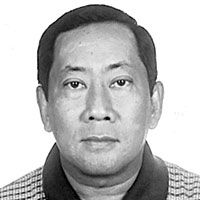War story about Cebu now in US archives!

October 12, 2005 | 12:00am
For many years now, we've been writing about the exploits of that American Mining Engineer who lead the Cebu guerrilla movement during World War II. Yes, I'm sure that by now you know that I'm talking about the late Lt. Col. James Cushing who died a poor man onboard a steamer to Palawan. He asked to be buried at the Libingan ng mga Bayani instead of the American Cemetery as he wanted to be with Filipino heroes.
The last I wrote about Col. Cushing was when my good friend, Lou Jurika came here a year ago and went looking for his grave at the Libingan. Unfortunately, they lost his grave despite the fact that his name appeared in the grave's registration list. Last week, my uncle, Col. Manuel Segura (Ret) came to the office bringing colored photos of a cross his friend took at the Libingan ng mga Bayani. The name James M. Cushing, Col. Army is emblazoned across this cross. However, something written below brought me to question this cross as the words "Capas-Death" was written below his name. Even my uncle, Col. Segura thought that to be so strange.
My reckoning here is that, more than a year ago we wrote that very embarrassing article about the missing grave of Col. Cushing. Who knows, maybe the Graves Officer had a new cross hastily built and placed somewhere. Then he had the name of Col. James Cushing carved into the cross. The problem however is, he didn't know the history of Col. Cushing and probably assumed that Cushing died in the Death March in Capas, Tarlac. So I'll just wait for my friend Lou Jurika to return to check whether this cross is for real or not.
Meanwhile, last June, I was surprised to get an email from Mr. Benjamin Guterman, editor/writer, Product Development Branch of the National Archives and Records Administration (NARA) in the United States, based in Washington D.C. Mr. Guterman probably read some of my articles about Col. Cushing whose daring exploits sparked a renewed interest by many people in the United States.
Mr. Guterman asked me if I could provide him with a photo of the late Col. Cushing and Mr. Salvador Abcede, the Commander of the Seventh Military District in Negros island because the National Archive's magazine "Prologue" was coming out with a feature story on his exploits in Cebu. Right away, I asked my uncle, Col. Segura who promptly sent me black and white photos of his old wartime friends. I emailed these photos to the US Archives to Mr. Guterman just in time for the publication.
The exploits of Col. Cushing was featured in my uncle's book "Tabunan" and later in another book he wrote "The Koga Papers" the first time that I know that the Z-Plan which is the defense of Japan against the Allies was written in a book. Recently, an American author Steven Trent Smith wrote another book "The Rescue" about 40 American missionaries caught up in Dumaguete during the Second World War, while the other half of that book also deals with the Koga Papers (where he generously quoted a lot of items from my uncle's book). Apparently, the Koga Papers and the American missionaries ended up being rescued in the same submarine, the USS Crevalle which brought them to the safety of Australia.
Last week, I got another email from Mr. Guterman informing me that the magazine "Prologue" had already come out including the photos that I supplied him and he was sending me a copy of the magazine. Meanwhile, he sent ahead an emailed copy of this story written by Greg Bradsher, entitled, "The Z Plan Story: Japan's 1944 Naval Battle Strategy Drifts into U.S. Hands." I printed this 12-page article and as a Cebuano, I'm proud to say that finally, an obscure historical incident that happened on March 31,1944, which happened in Cebu had come out of the US Archives magazine; therefore, it is now officially part of their historical records.
All told, the Koga Papers reached Gen. MacArthur's headquarters in Australia and after deciphering the Z Plan, the allied invasion planned for Sarangani Bay in southern Mindanao was abandoned and moved up to the lightly defended island of Leyte on October 10, 1944. Thanks to the books of Col. Segura and Steven Smith, and now, no less than the US Archives magazine "Prologue" has given this story historical prominence. With this, I renew my call to Cebu officials to erect a monument to Col. James Cushing, whose wartime exploits still goes unnoticed even in Cebu. It is now a historical fact that Adm. Shigeru Fukudome, Koga's Chief-of-Staff was the highest ranking Japanese officer ever captured in the Pacific War and the Cebu Guerrillas under Cushing did it! So isn't it the right time that we gave recognition to Col. Cushing and the Cebu Guerrillas for their heroic efforts?
For email responses to this article, write to [email protected]. Bobit Avila's columns can also be accessed through www.thefreeman.com
The last I wrote about Col. Cushing was when my good friend, Lou Jurika came here a year ago and went looking for his grave at the Libingan. Unfortunately, they lost his grave despite the fact that his name appeared in the grave's registration list. Last week, my uncle, Col. Manuel Segura (Ret) came to the office bringing colored photos of a cross his friend took at the Libingan ng mga Bayani. The name James M. Cushing, Col. Army is emblazoned across this cross. However, something written below brought me to question this cross as the words "Capas-Death" was written below his name. Even my uncle, Col. Segura thought that to be so strange.
My reckoning here is that, more than a year ago we wrote that very embarrassing article about the missing grave of Col. Cushing. Who knows, maybe the Graves Officer had a new cross hastily built and placed somewhere. Then he had the name of Col. James Cushing carved into the cross. The problem however is, he didn't know the history of Col. Cushing and probably assumed that Cushing died in the Death March in Capas, Tarlac. So I'll just wait for my friend Lou Jurika to return to check whether this cross is for real or not.
Meanwhile, last June, I was surprised to get an email from Mr. Benjamin Guterman, editor/writer, Product Development Branch of the National Archives and Records Administration (NARA) in the United States, based in Washington D.C. Mr. Guterman probably read some of my articles about Col. Cushing whose daring exploits sparked a renewed interest by many people in the United States.
Mr. Guterman asked me if I could provide him with a photo of the late Col. Cushing and Mr. Salvador Abcede, the Commander of the Seventh Military District in Negros island because the National Archive's magazine "Prologue" was coming out with a feature story on his exploits in Cebu. Right away, I asked my uncle, Col. Segura who promptly sent me black and white photos of his old wartime friends. I emailed these photos to the US Archives to Mr. Guterman just in time for the publication.
The exploits of Col. Cushing was featured in my uncle's book "Tabunan" and later in another book he wrote "The Koga Papers" the first time that I know that the Z-Plan which is the defense of Japan against the Allies was written in a book. Recently, an American author Steven Trent Smith wrote another book "The Rescue" about 40 American missionaries caught up in Dumaguete during the Second World War, while the other half of that book also deals with the Koga Papers (where he generously quoted a lot of items from my uncle's book). Apparently, the Koga Papers and the American missionaries ended up being rescued in the same submarine, the USS Crevalle which brought them to the safety of Australia.
Last week, I got another email from Mr. Guterman informing me that the magazine "Prologue" had already come out including the photos that I supplied him and he was sending me a copy of the magazine. Meanwhile, he sent ahead an emailed copy of this story written by Greg Bradsher, entitled, "The Z Plan Story: Japan's 1944 Naval Battle Strategy Drifts into U.S. Hands." I printed this 12-page article and as a Cebuano, I'm proud to say that finally, an obscure historical incident that happened on March 31,1944, which happened in Cebu had come out of the US Archives magazine; therefore, it is now officially part of their historical records.
All told, the Koga Papers reached Gen. MacArthur's headquarters in Australia and after deciphering the Z Plan, the allied invasion planned for Sarangani Bay in southern Mindanao was abandoned and moved up to the lightly defended island of Leyte on October 10, 1944. Thanks to the books of Col. Segura and Steven Smith, and now, no less than the US Archives magazine "Prologue" has given this story historical prominence. With this, I renew my call to Cebu officials to erect a monument to Col. James Cushing, whose wartime exploits still goes unnoticed even in Cebu. It is now a historical fact that Adm. Shigeru Fukudome, Koga's Chief-of-Staff was the highest ranking Japanese officer ever captured in the Pacific War and the Cebu Guerrillas under Cushing did it! So isn't it the right time that we gave recognition to Col. Cushing and the Cebu Guerrillas for their heroic efforts?
BrandSpace Articles
<
>
- Latest
- Trending
Trending
Latest
Recommended

December 20, 2024 - 10:56pm



























